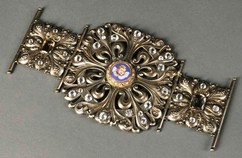 We live in a rather disposable era just now, with plastic buttons popping off in the laundry and pants with broken zippers being discarded, but in the past, the medieval past, luxury goods like fabric and closure accessories like buttons and clasps were difficult to come by. Their expensive nature meant they needed to be easily salvageable and clothing was designed with this in mind. Take for instance a cope, which is a long liturgical garment that is open in the front and originally had a cloth rectangular panel across the front that joined with hook and eye closures to keep the cope from slipping. These panels, known as morses, highly visible as they were on the breast of the wearer, came to be highly decorated, initially with elaborate embroidery and then later with gemstones sewn into the decorations. Naturally, as the wealth of the Church grew and as ceremonies and cathedrals became increasingly ornamented throughout the Middle Ages and into the modern era, the morse became a metalwork piece, a wrought clasp.
We live in a rather disposable era just now, with plastic buttons popping off in the laundry and pants with broken zippers being discarded, but in the past, the medieval past, luxury goods like fabric and closure accessories like buttons and clasps were difficult to come by. Their expensive nature meant they needed to be easily salvageable and clothing was designed with this in mind. Take for instance a cope, which is a long liturgical garment that is open in the front and originally had a cloth rectangular panel across the front that joined with hook and eye closures to keep the cope from slipping. These panels, known as morses, highly visible as they were on the breast of the wearer, came to be highly decorated, initially with elaborate embroidery and then later with gemstones sewn into the decorations. Naturally, as the wealth of the Church grew and as ceremonies and cathedrals became increasingly ornamented throughout the Middle Ages and into the modern era, the morse became a metalwork piece, a wrought clasp.
They are quite rare, or perhaps it is simply rare to recognize them for what they are or for them to be identified as such at auction, as medieval examples are well documented, both in museums and in the documents of European churches. This example, which sold recently at Skinner, Inc., is identified by its inscription and was likely a gift in memory of a church member. The central portrait is a micromosaic, a image composed like a mosaic, but with near-microscopic pieces.



